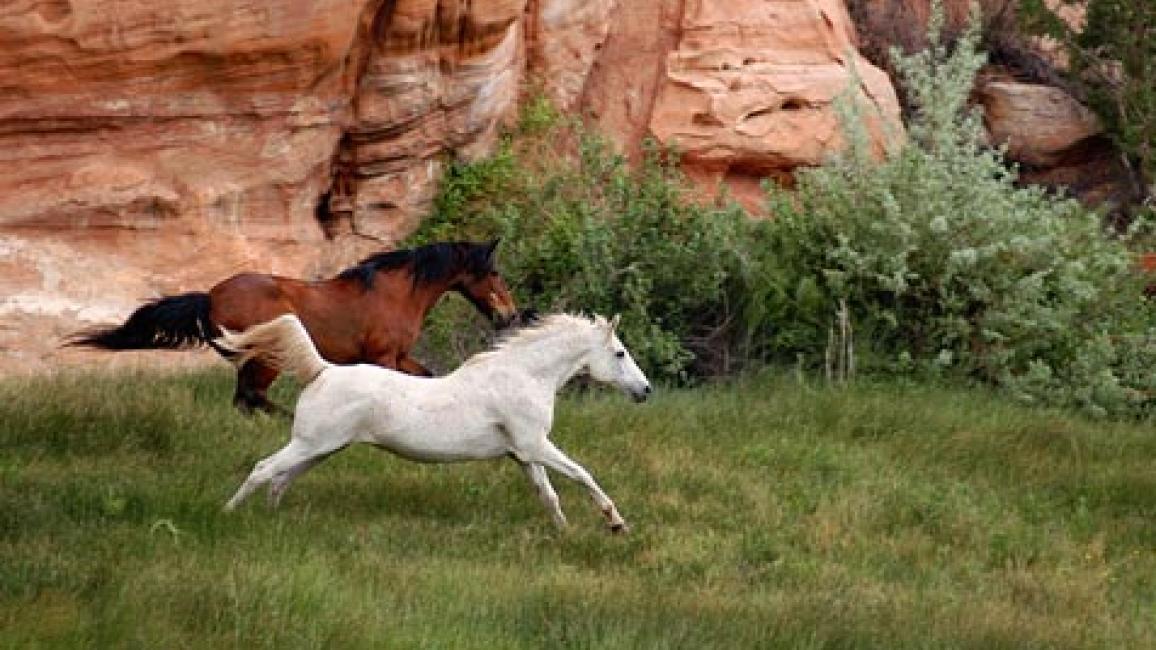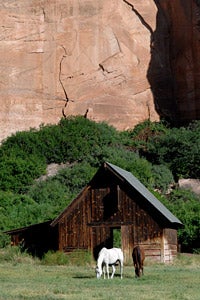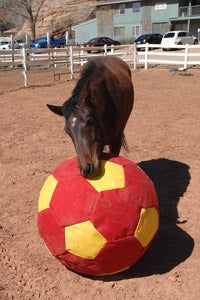Enrichment tips for horses

A walk-in closet can be a glorious organizational tool for the fashion-conscious. No matter how much you might love clothing, though, it doesn’t mean you’d want to spend 20 hours a day in there. Sad to say, for some horses, that’s about what life is like when they are kept in a stall. There’s a better way!

Darby and Amir
During Horse Week (May 9 – 13) at Best Friends, we thought we’d share a few tips to make sure the horses in your life wake up excited to start the day.
Exercising a horse
One of the main benefits you can provide a horse is to give him or her enough room to stretch those legs. Horses are built for running, not standing around in one spot. If they have enough space, they can exercise on their own whenever the mood strikes. It’s even better if they have a friend to do it with.
"Horses have a lot of play drive, and enjoy the company of others," explains Jen Reid, manager of Horse Haven at Best Friends. Horses are herd animals. They’re hard-wired to live with others. Unless you plan on moving into the pasture with your horse, he or she is going to be alone a lot of the time if you don’t bring in a friend. "It can provide them a lot of comfort having a buddy," points out Jen.
OK, so you’ve got yourself a spacious pasture with a couple of horses who can keep each other company. Congratulations! Are you done? Well, probably not. There are still lots of ways for a horse to grow bored. After all, these are highly intelligent animals. They usually need something to do during the day.

Curly Sue eating from the slow-feeding system
Horse enrichment: Keeping a horse from getting bored
Consider this. In the wild, a horse can spend between 16 to 18 hours a day foraging for food. On the other hand, in a pasture with a trough full of goodies, it takes hardly any time at all to eat. If the water source also happens to be right next to the food, well, then a horse may decide to park it in one spot anyway, regardless of available space. Of course, there are a few strategies that can help.
Slow-feeding a horse
At Best Friends, the horses are currently being introduced to a new slow-feeding system. Their food goes into a large and sturdy plastic box, with a lid on top. This lid has holes, through which the horses extract their food a tiny bit at a time. When the horses are fully switched over to this system, they’ll have constant access to food, but they’ll have to work to get it. Just like in the wild.
A slow-feeder does a terrific job maintaining their interest, and more closely mimics how they would eat naturally. The slow-feeding system also brings the added benefit of helping to prevent overeating. "So far the horses really seem to like it," says Jen.
Horse mazes
There’s another school of thought out there that uses fencing to stimulate mental activity. The idea is that instead of merely running a fence around the perimeter and having a large open space, you can create a maze of sorts through the area. Thus, if you place food at one end (or at multiple locations throughout), and say, place the water at another end, the horses will need to zip all over to reach everything. None of the horse pastures at Best Friends are currently set up this way, though Jen says she’d like to see it happen someday.

Mental enrichment
Toys for horses
Horse toys are also another draw. Horses can play with anything from gigantic balls, to food puzzles, to homemade toys. One example of an effective and inexpensive homemade toy is to take an empty orange juice jug, drill it full of holes, and fill it with goodies or vitamin supplements. Then horses can spend time shaking out the contents.
Sometimes the horse will take the lead, however, and decide that a pitch fork makes a wonderful toy to run off with. Or a pair of gloves. Or a pair of boots.
While the horses at Best Friends do have access to toys, they’re not used extensively. The horses tend to grow tired of any given toy before too long. Those inquisitive minds again! The best alternative is really quite simple: caregivers’ spending quality time with the horses.
"The training we do is all mental enrichment," explains Jen. There’s a reason the activities used in the Parelli training system — the training method used at the Sanctuary — are called "games." They’re meant to be fun! With such training exercises and other activities in place, horses can use their brains while simultaneously enjoying the extra company and attention.
Put enough of these enrichment activities into the mix, and your horses will never have to find themselves watching grass grow as the highlight of their day!
Photographs by Best Friends photographers
Adopt a horse from Best Friends Animal Sanctuary.